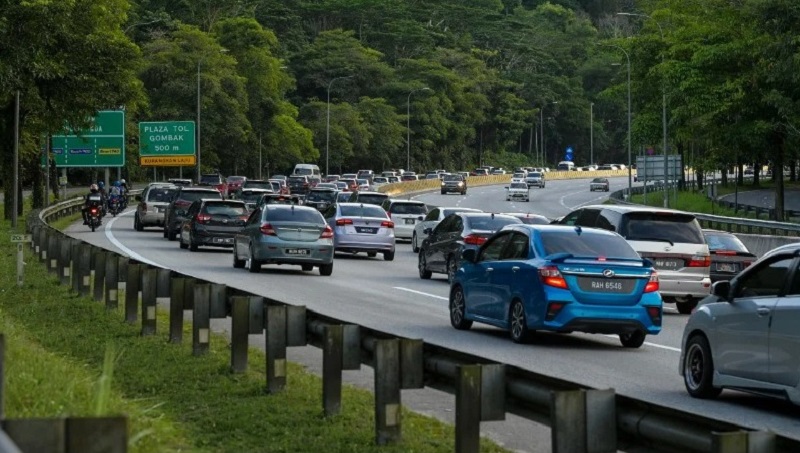WHAT comes to mind when thinking about driving during festive seasons or school holidays? Traffic congestion and higher accident rates, right? This is due to the increased number of vehicles on the road as many people have plans for vacations with family or friends.
The issue is that most of the congestion or traffic jams and accidents should not occur if our drivers are more disciplined and use common sense while driving, rather than solely relying on instinct. So this time, we would like to share six (6) ‘driving hacks’ that can be adopted to reduce the risk of congestion and road accident risks during the holiday season.
It is important to remember that these sort of ‘hacks’ are not too strange or new, but rather common things that we all already know and have learned. We will simply explain in more depth why practicing them will reduce congestion and the risk of accidents.
1. Maintain a distance from the car ahead
Just another common advice, isn’t it? Before you yawn from drowsiness, let us explain. Do you feel great because you’ve managed to aggressively squeeze in front of the car ahead?
Actually, this aggressive tailgating practice is not the smartest to adopt. Even if you ask professional racers, they do not drive closely on the road.
This is because by driving too close, you are likely to brake suddenly and repeatedly, triggering a domino effect for traffic flow, especially on highways.
Have you ever stopped in the rightmost lane of a four-lane highway? And when you move, you see that nothing is happening? Yes, this is the result of the “great” guy who tailgated 25 cars in front.
2. Avoid driving too slowly in the middle lane
“Hey, why can’t I drive slowly? Where are you in such a hurry to go?” Well, you can drive slowly, no one will be angry, but in the left lane, right? Not the middle lane.
For example, if there are three lanes on the highway, there should be THREE different speeds. But when you drive slowly in the middle lane, at the same speed as the left lane, there are only two different speeds on that highway. This causes unnecessary congestion.
What’s the point of building a three-lane highway if it operates the same as two lanes, right?
Even worse if it’s a four-lane highway, but three lanes with the same speed, only the right lane is a little faster. The reason? The slow driving gang in the middle lane. Congratulations.
3. Don’t be ashamed to sit on the left
This is a continuation of the previous ‘lifehack’, if we feel like driving slowly, chill out, use the left signal, and switch to the left lane. “Isn’t the left lane just for buses and trucks?” Heavy vehicles are prohibited from being in the rightmost lane, but for us ordinary passenger car drivers, it’s no problem to be in the left lane. There’s a difference.
If you feel like driving slowly, want to chat vigorously with the passengers, or ask someone at home to pass you snacks, this is the lane for that. Not the middle lane.
4. Accelerate in the merging lane BEFORE entering the main lanes
This is also an important lifehack. Did you know that the entrance merging lane to the highway is the most underused? Many are in a rush to get to the right lane but are still crawling, causing the cars in the main lane to brake for them.
As a result, another domino effect. You can see examples on the main highway during peak hours or the start of holidays. Traffic congestion near the merging lanes, then flowing smoothly again. Cars from the merging lane rush to enter the right lane even though the lane is still long. Any prizes for who gets to the right lane first?
Ideally, accelerate, signal right, and merge at the same speed. Not signal, merge casually, and then speed up. It’s tiring to teach one by one…
5. Looking far ahead
This ‘lifehack’ is actually one of the defensive driving techniques. Use whatever we can to see far ahead. Perhaps we can look ahead through the front car mirror, or maintain our distance. When we are too close to the front car, it’s more difficult for us to see what’s ahead of it.
For example, we can be prepared to slow down before the car in front hits the brakes. This is crucial for smooth traffic flow. Imagine if all drivers maintained distance, looked far ahead, and avoided sudden braking, surely the traffic flow would be smooth even with many cars.
6. Matching speed with traffic flow
Finally, the key to smooth driving is to drive at a speed that matches the traffic flow. Not too fast and not too slow. Driving too fast in heavy traffic, other drivers will think you’re possessed, and believe me, they’re all cursing you. If it’s an emergency, that’s a different story.
But driving too slowly is also dangerous because other cars have to change lanes a lot to “avoid” you. Like a stone rolling in a fast-flowing drain. Don’t be in your own world, driving as you please, “as long as you don’t exceed the speed limit,” it said. Follow the traffic flow, be aware of the surroundings.
How about the six driving ‘lifehacks’ we shared? If you’re not sure, it’s okay. Take a deep breath, and reconsider while driving during the holiday season. And try to observe the causes of congestion that occur. Drive safely!
